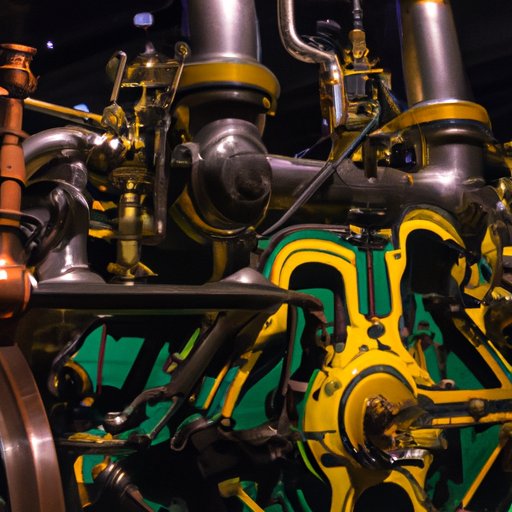Introduction
A steam engine is a machine that harnesses the power of steam to create mechanical energy. It was first developed during the Industrial Revolution and has been used for centuries as an efficient form of power. The steam engine has been instrumental in powering everything from trains and ships to factories and mills. It has even been used in some modern applications such as cars and turbines.

Exploring the Parts of a Steam Engine and How They Work Together
The steam engine is made up of several key components that work together to produce mechanical energy. These components include the boiler, cylinder, valve gear, piston, flywheel, drive shaft, and connecting rod. Each part plays a crucial role in the overall functioning of the steam engine.
The boiler is responsible for generating the steam that powers the engine. Water is heated inside the boiler until it turns into steam. This steam then travels through pipes to the cylinder, where it is used to push the piston.
The cylinder is the main chamber of the steam engine, where the steam is contained. Inside the cylinder is a series of valves that control the flow of steam. The valve gear is what operates the valves, allowing them to open and close in order to regulate the steam pressure.
The piston is responsible for converting the energy from the steam into mechanical energy. It is connected to the flywheel, which helps to keep the engine running smoothly by absorbing excess energy. The drive shaft transfers the mechanical energy from the flywheel to the connecting rod, which is connected to the wheels or other machinery that requires power.
A Step-by-Step Guide to Understanding the Mechanics of a Steam Engine
To better understand the mechanics of a steam engine, it is helpful to look at the process step-by-step. The following is a guide to understanding the process.
The first step is combustion. In this step, fuel is burned in the boiler, producing hot gases. These hot gases heat up the water in the boiler, turning it into steam.
The second step is the expansion of steam. The steam is forced through the valve gear and into the cylinder. As the steam expands, it pushes against the piston, creating mechanical energy.
The third step is the conversion of energy. The mechanical energy created by the piston is transferred to the flywheel, which absorbs the energy and stores it. The stored energy is then transferred to the drive shaft, which transfers it to the connecting rod.
The final step is the exhaust. After the energy has been transferred to the connecting rod, the remaining steam is released through an exhaust pipe. This steam is then cooled and condensed back into water, which is then recycled back into the boiler.

An Overview of the History and Evolution of the Steam Engine
The history of the steam engine dates back to the early 18th century. Early models were developed by inventors such as Thomas Newcomen and James Watt. These early models were used mainly for pumping water out of coal mines. During the Industrial Revolution, steam engines became more advanced and were used to power factories and mills.
In the 20th century, steam engines began to be used in transportation, most notably with the railroad. Steam engines were also used to power ships and some automobiles. Today, steam engines are still used in some applications, including power plants and turbines.
Investigating the Principles Behind the Functionality of a Steam Engine
The functionality of a steam engine is based on several scientific principles. The first is the laws of thermodynamics, which describe how energy is transferred between objects. Heat transfer is another important principle, which explains how energy is transferred from a hotter object to a colder one.
Pressure dynamics is also essential to understanding the functioning of a steam engine. Pressure is created by the expanding steam, which pushes against the piston and creates mechanical energy. This energy is then transferred to the flywheel, which stores it until it is needed.

Examining the Benefits of Using a Steam Engine in Everyday Applications
Today, steam engines are still widely used in many everyday applications. One of the major benefits of using a steam engine is cost efficiency. Steam engines are very efficient at converting energy, which means they require less fuel to generate the same amount of power as other forms of energy production.
Another benefit of using a steam engine is mobility. Steam engines are relatively small and lightweight, making them easy to move and install. This makes them ideal for use in applications that require portability, such as locomotives and ships.
Finally, steam engines are known for their reliability. They require minimal maintenance and can run for long periods of time without needing repairs. This makes them well-suited for applications that require reliable power, such as factories and mills.
Conclusion
The steam engine is a powerful and versatile form of power that has been used for centuries. It is composed of several key components that work together to produce mechanical energy. By understanding the principles behind its functionality, we can better appreciate the benefits of using a steam engine in everyday applications. From cost efficiency to mobility and reliability, the steam engine continues to be a valuable source of power in our modern world.
(Note: Is this article not meeting your expectations? Do you have knowledge or insights to share? Unlock new opportunities and expand your reach by joining our authors team. Click Registration to join us and share your expertise with our readers.)
